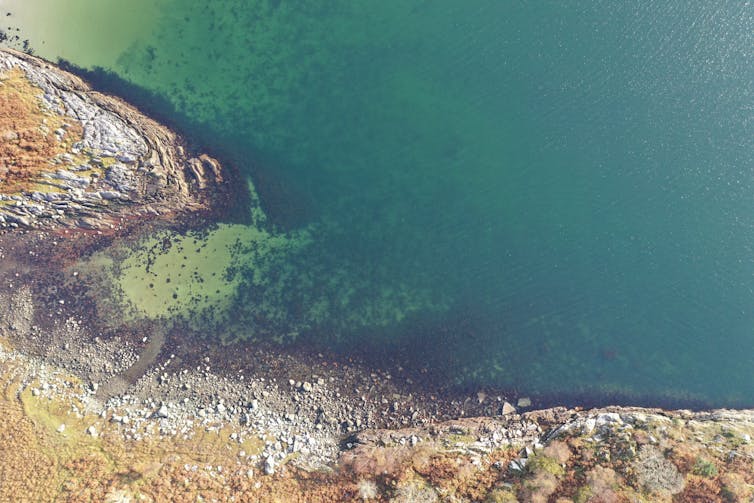The UK has seen some exciting marine visitors recently, such as walruses, humpback whales and bluefin tuna, but a current group of arrivals has been much more of a cause of concern. Large numbers of huge stinging jellyfish have been appearing off the west coast of Scotland.
If holidaymakers in Scotland this summer spot a jellyfish, it is most likely to be the lion’s mane (Cyanea capillata). This stunningly beautiful animal, pictured in the main image, can be one of the biggest jellyfish in the world. The largest specimen recorded had a diameter of over 2m and tentacles trailing back nearly 37m from the main body, making it probably the longest animal in the world (a blue whale’s maximum length is 30m).
Because jellyfish are hard to catch and count, it is hard to get the data to confirm that they are definitely more plentiful in UK waters than in previous years. But if the anecdotal evidence is correct, what could be causing this?
Why do there seem to be more jellyfish?
The lion’s mane jellyfish is actually a cold-water, northern species, so mostly found in the waters to the north of Scotland, although there are sightings around the north Wales coast and a smaller number in other places around the UK.
Despite their large size, jellyfish are still members of the plankton community – these are organisms floating in the surface layer of the sea that are at the mercy of currents and winds to move them across the oceans. While they can move up and down, their speed is not enough to counter the water movement – animals that can do this (such as fish, turtles, squid) are termed nekton.
This means that the lion’s mane is moved along by the main ocean current and wind direction. When these forces meet land, the jellyfish have nowhere to go and so more and more gather there, just like cars on a motorway blocked by an accident.
The right weather pattern, pushing water in from the north or north west, will act with the ocean currents to bring these northern visitors to our shores – some years this will happen, at other times the jellyfish will not be this far south. When it does happen, it will usually be in late summer and autumn once they have grown. Such jellyfish pile-ups have even caused the closure of nuclear power stations in previous years.
Lion’s mane jellyfish sightings, 2003-19

Kate Duncan/Marine Conservation Society, Author provided
There is also evidence that in some parts of the world, including around the UK, jellyfish blooms (where the jellyfish population rises suddenly) are increasing. This is potentially linked to climate change, including the warming of the oceans and changes to the acidity of sea water. But given that the lion’s mane jellyfish are coming from the north, this is unlikely to be the explanation in this case.
Among other possible explanations for increasing numbers of jellyfish is the impact of over-fishing: by removing the fish from the ocean surface that would usually compete with jellyfish for food, they find it easier to thrive. Natural predators of jellyfish, such as leatherback turtles and sunfish, are also seen in lower numbers than in the past.
Like all jellyfish, lion’s mane only live for a year, giving an indication of how fast they grow. They start life as a little polyp on the seabed, like a small sea anemone, which buds off tiny medusae (the jellyfish stage) that join the plankton community at the surface of the ocean.
Here they are voracious predators, feeding off the rich soup of other small animals within the plankton, including juvenile fish, to support their fast growth. This means that having potentially benefited from over-fishing, large swarms of jellyfish can have a major further impact on fish stocks. To catch their prey, the long tentacles of the lion’s mane are armed with special stinging cells called nematocysts which function a bit like a harpoon, triggered by touch to send a poison dart into their prey. The paralysed and captured prey are then pulled back up to the jellyfish – think of a fisher with long lines of hooks trailing back from their boat.

Sol Milne/Shutterstock
What to do if you are stung
The stings of most jellyfish are not harmful to humans, but for some species their toxin is strong enough to cause serious problems. The box jellyfish (Chironex fleckeri) off Australia is considered to be the world’s most venomous marine animal, the sting of which can stop a human heart within five minutes. The lion’s mane sting is unlikely to be fatal, unless you have for example a heart condition or allergy. But it can still be painful – some people liken it to a wasp sting; others to a bad nettle rash.
The best treatment is to try and wash off any remaining stings with sea water (not fresh water – and try not to touch the stings with another part of the body) and then soak the affected area with some form of mild acid, such as vinegar, as soon as possible. Despite what you may hear, don’t wee on a jellyfish sting – urine can be more likely alkali than acidic.
If you feel further symptoms such as sickness or abdominal pain, seek medical help urgently. It is also highly advisable to avoid contact with any jellyfish – for example if you are in the water, swim in front of a jellyfish, not behind it where the tentacles may be trailing and hard to see. Even when washed up on the beach, the stings can still be active.
You can also really help us understand the patterns of jellyfish movements, and if they are getting more common, by reporting any UK sightings you may have to the Marine Conservation Society’s online jellyfish survey page. There is also a handy guide to find out what species you have seen, so a chance for anyone who encounters a jellyfish to help with the science.
![]()
Martin Attrill is a trustee for both the Manta Trust and Ocean Conservation Trust.











